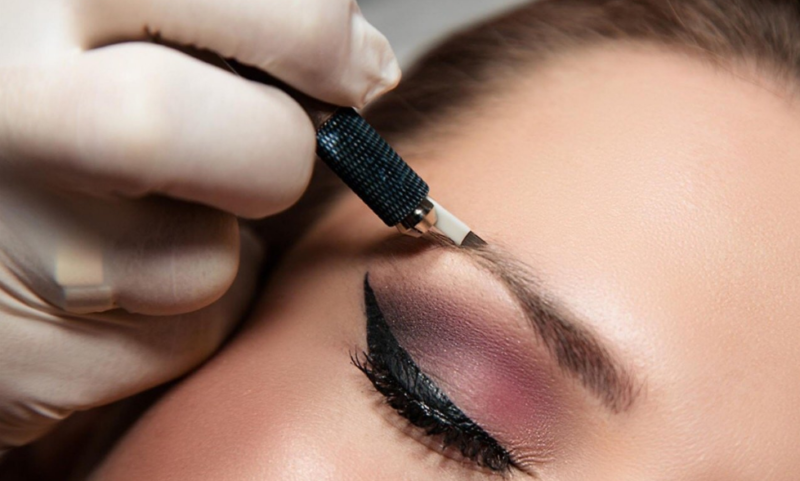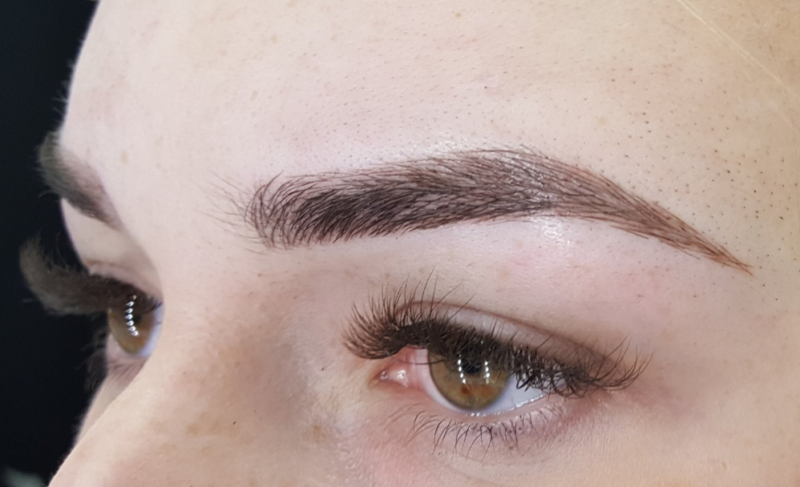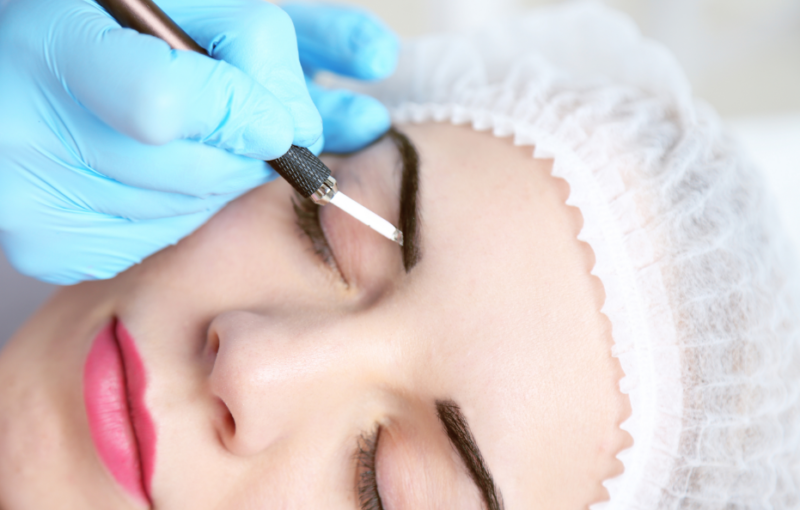Looking attractive is every woman’s dream. Daily face care has long been the norm for everyone, but today the beauty industry offers many ways to not only maintain natural beauty, but to improve it or hide flaws. One of them is microblading eyebrows. Learn about the features of the procedure, indications and limitations to the procedure from our article.
Material Content:
What is eyebrow microblading
Translated from the original language, the name of the technique means "micro-blade." This is an innovation in the beauty industry, the principle of which is that the cosmetologist, working with a special pen-manipulator, draws contours of artificial eyebrows on the skin under natural hairs. The tool is a special handle equipped with a cluster of small needles, and they are different in length. With this device, the master draws the eyebrows by introducing a special pigment into the surface layers of the dermis.
Microblading eyebrows look well-groomed. They are not at all different from natural ones. Experts believe that today is the best way to change the brow arc.
Varieties of Permanent Makeup
In modern cosmetology, there are various ways to adjust the shape of eyebrows.
Permanent makeup is done by the following methods:
- European. It is also called a mannequin. The eyebrow in this procedure takes a clear outline, the drawn hairs are equal in length, thickness and equally directed. This method is often used when it is necessary to correct the brow arc.
- Oriental. Recreates strokes of different lengths and thicknesses, as well as directions. Thus making the eyebrow more natural. This method takes longer than the first.
- Powdery technique. Suitable for fair sex with blond hair. The master shades the pigment in separate strokes and gives the impression that the brow arches are covered with shadows.
- Hair technique. Drawing individual hairs. Suitable for those with very rare eyebrows.
- Shadow technique. It is carried out by light shading of the pigment.
The master in the salon will help you choose a method for a particular face type.
How to do, description of the techniques
Before doing this procedure, you need to talk with a cosmetologist in advance, so that the master makes a sketch and helps determine the shape of the eyebrows. By the way, some masters take photos before and after microblading to show clients how their face changes for the better after the procedure.
Before eyebrow tattooing, it is not recommended to drink coffee or caffeinated products. And also in two days it is necessary to completely exclude from the diet alcoholic beverages that cause blood thinning, and drugs containing antibiotics.
European methodology:
- Initially, the choice of the appropriate shade of the coloring pigment is determined, it should ideally fit the natural color of the eyebrows.
- The areas that undergo the procedure are treated with an anesthetic. This action will make manipulation less painful.
- Next, with a special pencil, a new shape of the eyebrows is applied. At this stage, any flaws are eliminated.
- Then a pigment with an appropriate shade is introduced under the skin using a manipulator pen. Draws hairs that are equal in thickness and have one shade. The distance between them is strictly maintained. This method makes the eyebrows thicker and more voluminous.
- Further, excess pigment is removed from the skin and the area where the procedure was performed is smeared with a softening cream.
Eastern methodology:
- The procedure begins in the same way as in the above method, with a discussion of the shape and drawing a new shape of the eyebrow.
- Then a special anesthetic is applied to the area above the eyes. After 15 minutes, the eyebrows are wiped with a disinfectant.
- Using a manipulator pen, the beautician makes microscopic strokes on the skin, introducing the selected pigment into them. Hair is drawn in different lengths and in different directions.
- After the procedure, the pigment is removed from the skin, the area above the eyes is smeared with a nourishing cream.
Beauticians recommend a week before microblading not to pluck eyebrows and not to treat this area with creams. In the "critical" days, it is better to refrain from the procedure.
Eyebrow care after microblading
After any cosmetic procedure, you should adhere to certain recommendations, and microblading is no exception.
They are as follows:
- In the first day you cannot wet your eyebrows, limit the touch of hands in this area and it is not recommended to be in the sun for some time. After the procedure, the area above the eyes will swell, but this phenomenon will disappear the next day.
- After microblading, the appearance of a succession is possible. To solve this problem, you need to use a lint-free napkin that needs to be moistened with Chlorhexidine.
- After microblading, a crust appears that cannot be soaked or peeled. The scab will dry on its own and fall away.
- After 3 days, the eyebrows should be lubricated with Dexpanthenol ointment. This remedy will help speed healing.
- Use of cosmetics is allowed a week after the procedure. The same time you can’t visit the bathhouse, sauna, solarium, beach.
- Cosmetic procedures, peeling should be postponed for 2 weeks.
If eyebrow care is followed correctly after microblading, then correction can be done after 1 - 1.5 months.
How long does the effect last?
A very common question: how long does eyebrow microblading last? The durability of the result depends on several criteria: the density and shade of the real hairs, the depth of pigment entry, the quality of the dye used and, of course, the professionalism of the cosmetologist. And also experts note that after 40 years, microblading lasts much longer, since at this age the skin is prone to dryness.
On average, the result is stored for 12 to 17 months.
It should be noted that compliance with the cosmetologist's recommendations for the care of pigmented eyebrows is of great importance in maintaining firmness.
Advantages and disadvantages
Like any cosmetic procedure, microblading has its pros and cons. Let's consider them closer.
Benefits:
- The pigment actively penetrates the skin, which allows you to achieve the desired shape of the eyebrows and their rich shade already at the first visit.
- The process takes a short time and is suitable for hypersensitive skin.
- Eyebrow contour is more natural, in comparison with other techniques.
- Since the hairs are drawn separately, the effect of thick eyebrows is achieved.
- The procedure almost completely eliminates puffiness of the skin, which can not be said about tattooing.
- The skin is minimally exposed to needles and therefore no bruising or sores appear.
- The ability to select a pigment shade that is more suitable for the natural color of the eyebrows.
- Carrying out the procedure eliminates age restrictions, which means that any woman can afford microblading if she does not have individual contraindications.
- A shorter healing period than with other similar techniques.
Contraindications:
- Since the microblading method has just appeared in cosmetology and the procedure is not cheap, not every woman can afford it.
- For faster recovery, certain care is required with the mandatory observance of certain recommendations.
- You can see the natural shade of the eyebrows only after a month.
- Two years later, the tattoo fades, to return the color, you must repeat the procedure.
Since the innovation in cosmetology has appeared recently, there are still very few professional masters.
List of contraindications
The latest procedure is not available to every representative of the weaker sex, since there are a number of restrictions.
Microblading should be discarded under the following circumstances:
- during the menstrual cycle;
- in the presence of cancer;
- if there is insulin-dependent diabetes;
- with diseases of the skin, psyche;
- with epilepsy;
- if blood coagulates poorly;
- with a predisposition to the formation of keloid scars;
- with panic attacks;
- with exacerbation of herpetic infection;
- during lactation and pregnancy;
- with hepatitis.
And also a contraindication will be an individual intolerance to the coloring pigment. To find out about the presence of such a reaction is very simple. It is necessary to apply a little pigment on the elbow, and if there are unpleasant sensations, then there is still an allergy.















